Sony CECHH12, CECHH06, CECHH07 User Manual
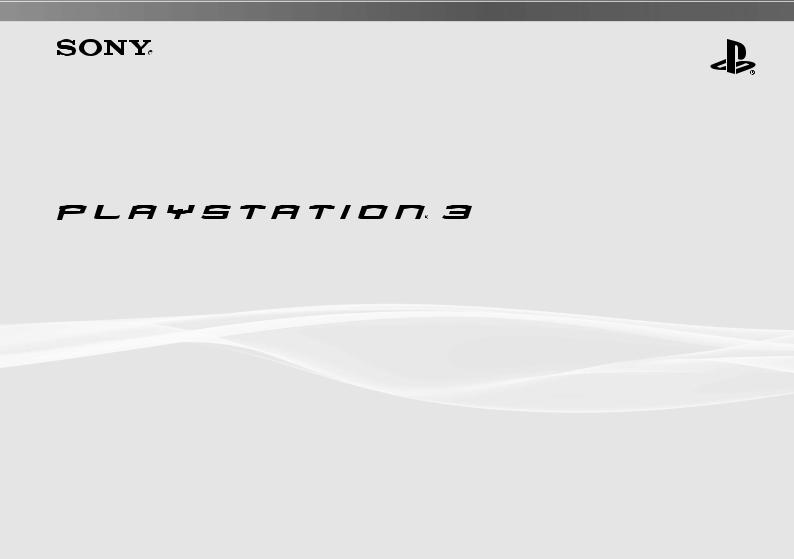
Quick Reference
CECHH06
CECHH07
CECHH12 |
3-285-687-51(1) |
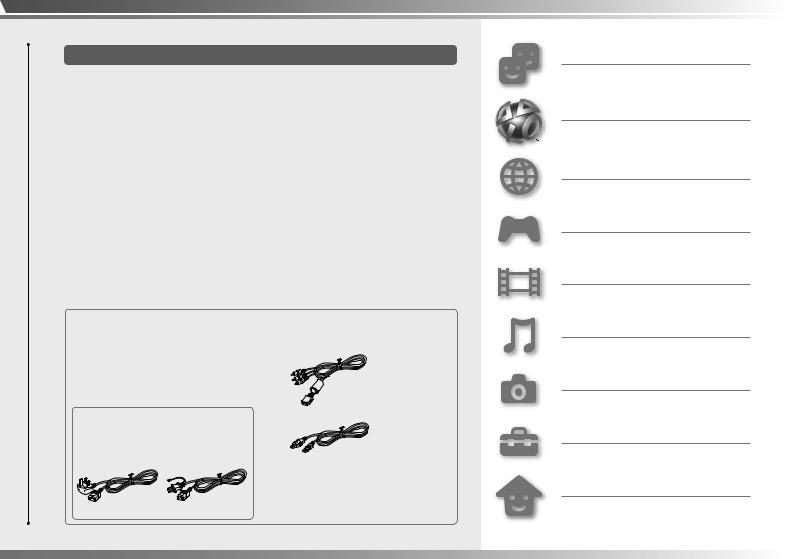
About the PS3™ system documentation
The PS3™ system documentation includes the following:
• Safety and Support
Before using the product, carefully read this document first. It contains safety information related to use of the PS3™ system, troubleshooting, specifications and other information.
• Quick Reference (this document)
This document contains information on setting up the PS3™ system, preparing for use and basic hardware operations.
• User’s Guide (http://manuals.playstation.net/document/)
This online document is accessed through the Internet and contains detailed information related to the use of the PS3™ system software (
 page 29).
page 29).
Check that you have all of the following items. If any items are missing, contact the PS3™ service line at the number listed on your warranty card for assistance.
s PLAYSTATION®3 system
s SIXAXIS™ wireless controller
s Printed materials
s AC power cord
One of the following two cable types is supplied with the system. The plug confi guration varies depending on the country or region.
s AV cable
s USB cable
2
Friends
Chatting and exchanging messages
PLAYSTATION®Network
Using PLAYSTATION®Network services
Network
Connecting to the Internet
Game
Playing games
Video
Playing video
Music
Playing music
Photo
Displaying images
Settings
Adjusting PS3™ system settings
Users
Selecting users to log in to the PS3™ system
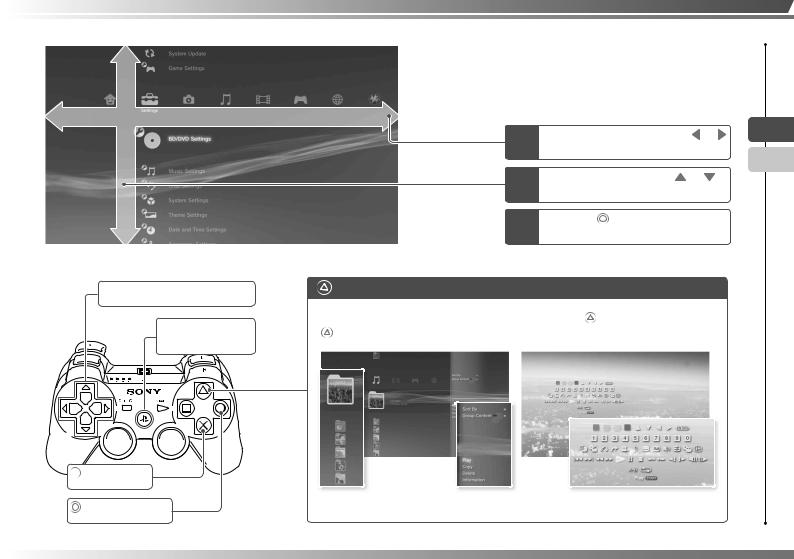
Item
Directional buttons:
Used to select on-screen categories/items
PS button:
Displays the home menu
Turns the system on/off
 button:
button:
Cancels an operation
button:
Confi rms the selected item
Home menu Using "XMB" (XrossMediaBar)
The PS3™ system includes a user interface called "XMB"
(XrossMediaBar). The main screen for "XMB" is called the "home |
|
||||
menu". |
|
|
|
|
|
Category |
|
|
|
|
|
|
1 |
Select a category using the |
or |
EN |
|
|
|
||||
|
button. |
|
|
|
|
|
|
|
|
CT |
|
|
|
|
|
|
|
|
2 |
Select an item using the |
or |
|
|
|
button. |
|
|
|
|
|
|
|
|
|
|
|
3 |
Press the |
button to confirm the |
|
|
|
selected item. |
|
|
||
|
|
|
|
||
button: Displays the options menu/control panel |
|
|
|
||
Selecting an icon and pressing the |
Pressing the button during content |
|
|||
button will display the options menu. |
playback will display the control panel. |
|
|||
Icons |
Options menu |
Control panel |
3

Getting started
01 Part names
System front
PS family logo
Can be rotated to match the position of the system
Disc slot


 Power button
Power button
Eject button
WLAN access indicator
HDD access indicator
USB connectors
 Caution
Caution
•Do not use the system in a closed cabinet or other locations where heat may build up. Doing so may cause the system to overheat and may lead to fi re, injury or malfunction.
•If the system’s internal temperature becomes elevated, the power indicator will fl ash alternately in red and green. In this case, turn off the system (
 page 16) and leave it unused for a while. After the system cools down, move it to a location with good ventilation, and then resume use.
page 16) and leave it unused for a while. After the system cools down, move it to a location with good ventilation, and then resume use.
System rear
AV MULTI OUT connector
DIGITAL OUT (OPTICAL) connector
MAIN POWER switch
AC IN connector
Vent
LAN connector
HDMI OUT connector
Hint
The system can be set in a horizontal or vertical position. Set as shown in the diagram at right when setting in the vertical position.
Notice
Do not place the system in an area subject to excessive dust or cigarette smoke. Dust build-up or cigarette smoke residue on the internal components (such as the lens) may cause the system to malfunction.
4
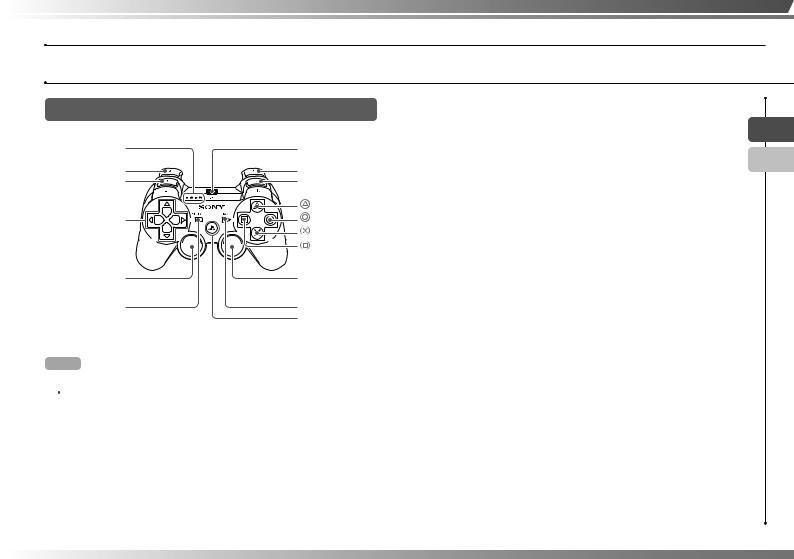
Getting started
Part names
SIXAXIS™ wireless controller
EN
Port indicators |
USB connector |
CT
L2 button |
R2 button |
L1 button |
R1 button |
|
button |
Directional |
button |
buttons |
button |
|
button |
Left stick/ |
Right stick/ |
L3 button* |
R3 button* |
SELECT button |
START button |
|
PS button |
* The L3 and R3 buttons function when the sticks are pressed.
Hints
•For details on the wireless controller, see "Using the wireless controller" ( page 17).
page 17).
•The SIXAXIS™ wireless controller that is supplied with this system is not equipped with a vibration function.
5
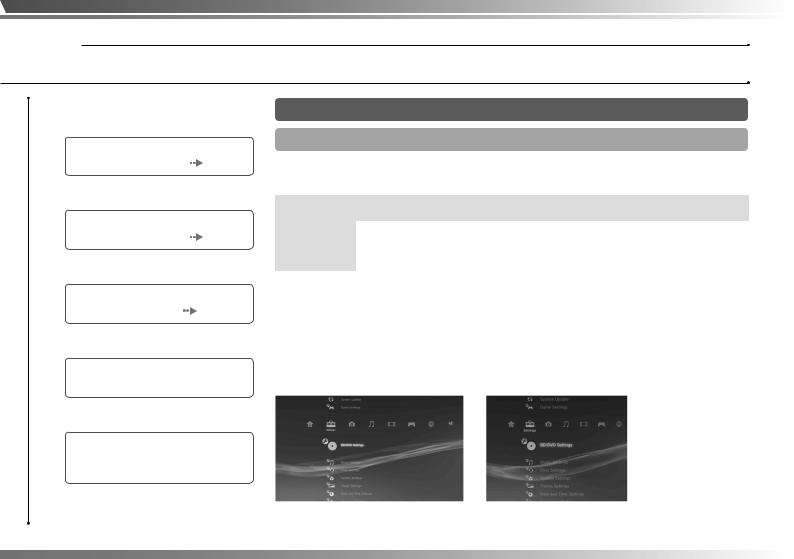
Getting started
02 Setting up the PS3™ system
Procedure flow for setting up the system
Step 1: Connect to a TV.
|
Page 6 |
m |
|
Step 2: Connect digital audio |
|
devices. |
Page 9 |
m |
|
Step 3: Connect an Ethernet |
|
cable. |
Page 10 |
m
Step 4: Connect the AC power cord.  Page 11
Page 11
m
Step 5: Perform initial setup of the system software.
 Page 11
Page 11
Step 1: Connect to a TV
Video output on the PS3™ system
The PS3™ system can output two types of resolution: HD and SD. Refer to the instruction manual for the TV in use to check which video mode is supported.
|
|
HD (High Definition) |
|
SD (Standard Definition) |
|||
|
|
|
|
|
|
|
|
Video mode *1*2 |
1080p |
1080i |
|
720p |
480p |
480i |
3 |
|
*4 |
||||||
|
|
|
|
|
576p |
576i |
* |
Aspect ratio |
16:9 |
16:9 |
|
16:9 |
16:9 |
16:9 |
|
|
4:3 |
4:3 |
|
||||
|
|
|
|
|
|
||
*1 This number indicates the number of scan lines. Note that "i" stands for "interlace" and "p" stands for "progressive". Using progressive results in high-quality video with minimal fl ickering.
*2 SD resolution varies depending on the model of the PS3™ system in use and the content that is being played. *3 The video output setting on the system will display as "Standard (NTSC)".
*4 The video output setting on the system will display as "Standard (PAL)".
Screens showing the difference in resolution
HD screen |
SD screen |
6
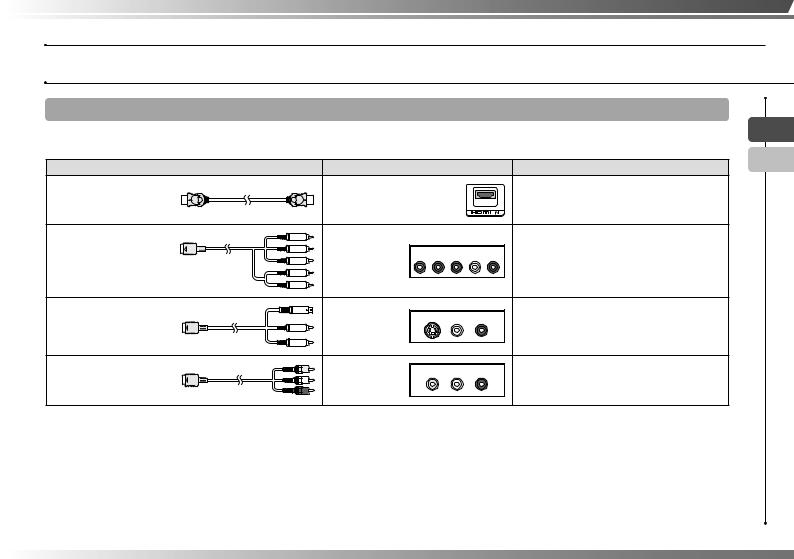
Getting started
Setting up the PS3™ system
Video output cable types
The resolution displayed on the TV varies depending on the input connectors on the TV and the type of cable in use. Select a cable to match the TV in use.
Cable type |
Input connector on the TV |
|
Supported video modes *1*2 |
|
|||
HDMI cable |
HDMI IN |
|
|
|
1080p, 1080i, 720p, 480p / 576p |
||
(sold separately) |
connector |
|
|
|
|||
|
|
|
|
|
|||
Component AV cable |
Component |
COMPONENT VIDEO IN |
AUDIO IN |
|
|
||
Y PB/CB PR/CR |
L R |
1080p, 1080i, 720p, 480p / 576p, 480i *3 |
/ 576i *4 |
||||
VIDEO IN |
|||||||
(sold separately) |
connector |
|
|
|
|
|
|
|
|
|
|
|
|
||
S VIDEO cable |
S VIDEO IN |
S VIDEO |
L-AUDIO-R |
480i *3 / 576i *4 |
|||
|
|
|
|||||
(sold separately) |
connector |
|
|
|
|
|
|
AV cable |
VIDEO IN |
VIDEO |
L-AUDIO-R |
480i *3 / 576i *4 |
|||
connector |
|
|
|
||||
(supplied) |
(composite) |
|
|
|
|
|
|
|
|
|
|
|
|
||
EN
CT
*1 Depending on the type of TV or content to be played, some video modes may not be supported.
*2 SD resolution varies depending on the model of the PS3™ system in use and the content that is being played. *3 The video output setting on the system will display as "Standard (NTSC)".
*4 The video output setting on the system will display as "Standard (PAL)".
7
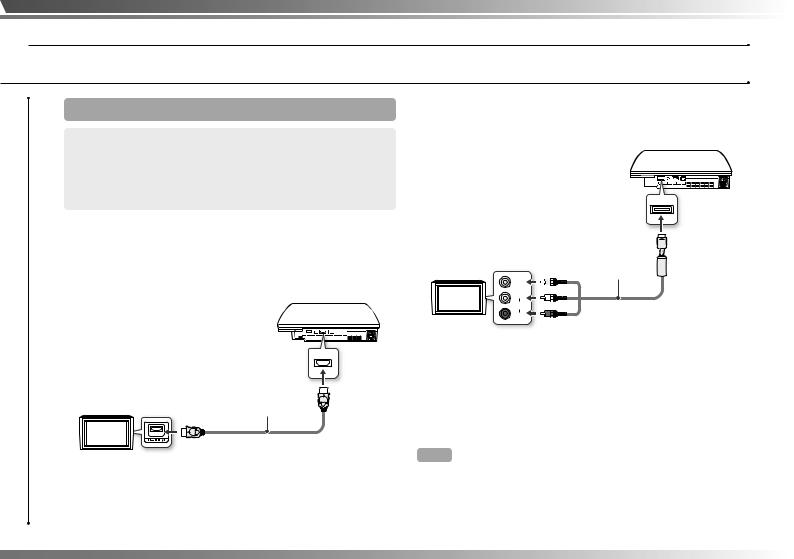
Getting started
Setting up the PS3™ system
Connection methods
 Caution
Caution
•Do not plug the AC power cord for the system into an electrical outlet until you have made all other connections.
•The socket-outlet shall be installed near the equipment and shall be easily accessible.
Connecting to a TV using an HDMI cable
Connect the system to the TV using an HDMI cable (sold separately). An HDMI cable can output both video and audio and enables you to enjoy digital-quality video and audio with minimal loss of picture quality.
|
HDMI OUT connector |
TV |
HDMI cable (sold separately) |
|
HDMI IN connector |
Connecting with other types of cables
Connect cables other than the HDMI cable to the AV MULTI OUT connector on the system.
AV MULTI OUT connector
TV |
AV cable (supplied) |
|
|
|
VIDEO |
|
L |
|
AUDIO |
|
R |
VIDEO IN connector
Example: When using the supplied AV cable
Hint
If you change the type of cable used to connect the system, video may not be displayed. If this happens, turn off the system and then turn it on again by touching the power button on the system front for at least fi ve seconds (until the system beeps twice). The video output setting will then be reset to the standard resolution.
8
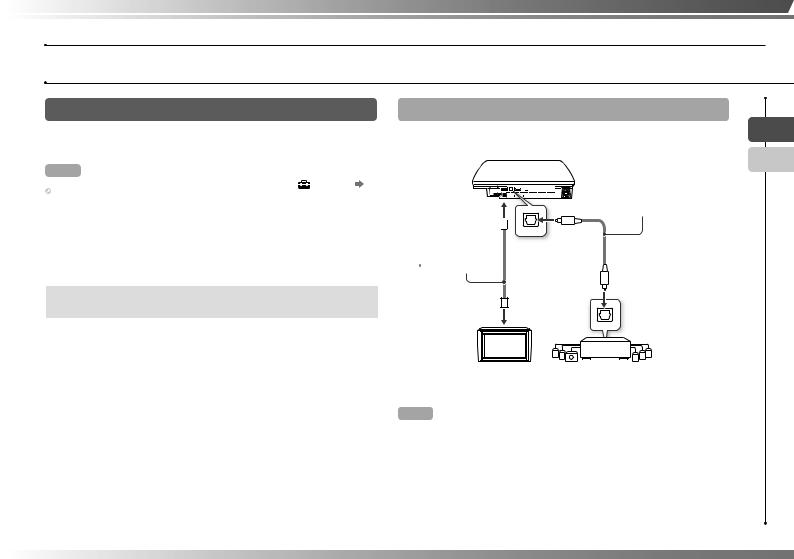
Getting started
Setting up the PS3™ system
Step 2: Connect digital audio devices
You can connect audio devices that support digital audio output, such as an AV receiver for home entertainment use.
Hint |
|
When connecting a digital audio device to the system, go to |
(Settings) |

 (Sound Settings)
(Sound Settings)  "Audio Output Settings", and then adjust the settings as necessary for the audio device.
"Audio Output Settings", and then adjust the settings as necessary for the audio device.
Audio output on the PS3™ system
The supported channels may vary depending on the output connector to be used.
PS3™ system output connectors |
Channels that can be used for output |
|||
2 Ch. |
5.1 Ch. |
7.1 Ch. |
||
|
||||
AV MULTI OUT connector |
|
|
|
|
|
|
|
|
|
Digital out (optical) connector |
|
|
|
|
|
|
|
|
|
HDMI OUT connector |
|
|
*1*2 |
|
*1 A device compatible with Linear PCM 7.1 Ch. is required to output 7.1 Ch. audio from the HDMI OUT connector.
*2 This system does not support output from the DTS-HD 7.1 Ch. DTS-HD 7.1 Ch. audio is output from a 5.1 or lower channel.
Connecting with an optical cable
Audio will be output from the optical cable. Video will be output from the video output cable.
Optical cable for audio (sold separately)
Video output cable for the TV in use
( page 7)
page 7)
TV |
Digital audio device |
|
such as an AV receiver |
Hint
Normally, audio cannot be output simultaneously from multiple output connectors. For example, if your PS3™ system is connected to a TV via an HDMI cable and to an audio device via a digital optical cable and "Digital Out (Optical)" is set under "Audio Output Settings", audio will no longer be output from the TV and will only be output from the audio device.
EN
CT
9

Getting started
Setting up the PS3™ system
Connecting with an HDMI cable
Both audio and video will be output from the HDMI cable. You can output the TV picture via an audio device.
Step 3: Connect an Ethernet cable
Using a commercially available Ethernet cable, you can connect the system to the Internet. For details on network settings, see "Adjusting network settings" ( page 24).
page 24).
 Caution
Caution
The system supports 10BASE-T, 100BASE-TX and 1000BASE-T networks. Do not connect a standard telephone line or other types of cords or cables that are not compatible with the system directly to the LAN connector on the system, as this may cause heat build-up, fi re or malfunction.
 HDMI cable (sold separately)
HDMI cable (sold separately)
Digital audio device such as an AV receiver



 HDMI cable (sold separately)
HDMI cable (sold separately)
TV
Hints
•If your TV is not equipped with an HDMI input connector, use a video output cable of the correct type for your TV ( page 7) to connect it to the PS3™ system directly.
page 7) to connect it to the PS3™ system directly.
•If a device is connected to the PS3™ system via an HDMI cable, do not turn off the device while the system is turned on (power indicator is lit solid green). Doing so may cause sound distortions or produce abnormal sounds.
Commercially available Ethernet cable
LAN connector |
LAN access indicator
Hint
You can connect to the Internet without using an Ethernet cable. For details, see "Using a wireless connection" (
 page 25).
page 25).
10
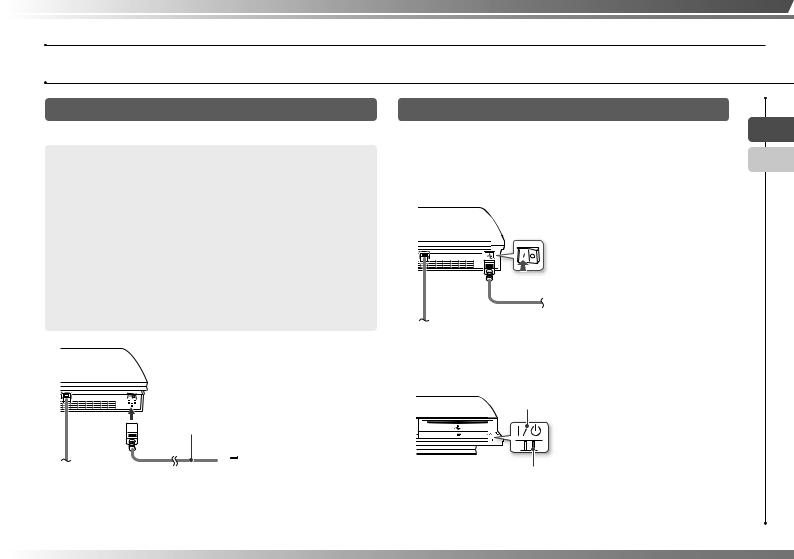
Getting started
Setting up the PS3™ system
Step 4: Connect the AC power cord
Connect the AC power cord.
 Caution
Caution
•Do not plug the AC power cord for the system into an electrical outlet until you have made all other connections.
•The socket-outlet shall be installed near the equipment and shall be easily accessible.
•If the supplied AC power cord includes a ground wire, follow the steps below.
–Before plugging the AC power cord into the electrical outlet, be sure to connect the ground wire first.
–If the ground wire is not connected, it may cause electrical shock. If the wire cannot be connected, contact an electrician to complete this step.
–When removing the AC power cord from the outlet, be sure to remove the ground wire as the last step.
 AC IN connector
AC IN connector
AC power cord (supplied)


 To the electrical outlet
To the electrical outlet
Step 5: Perform initial setup of the system software
After turning on the system, perform initial setup.
1 Turn on the TV.
2 Turn on the main power switch.
Main power switch
The power indicator turns solid red to indicate that the system has entered standby mode.
3 Touch the power button.
Power button
Power indicator
EN
CT
The power indicator turns green and the picture is displayed on the TV screen.
11
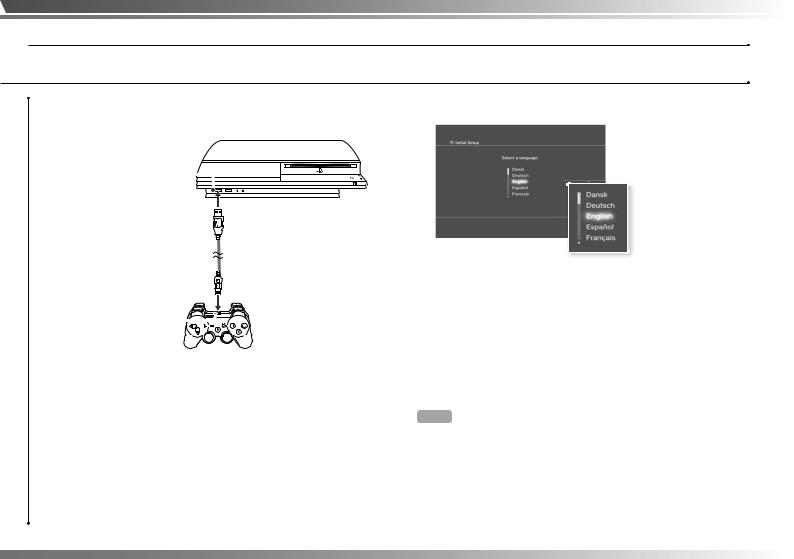
Getting started
Setting up the PS3™ system
4 Connect the wireless controller to the system using a USB |
6 Perform initial setup. |
cable. |
|
USB connector
USB cable (supplied) 
USB connector


5 Press the PS button of the controller.
The system will recognize the controller. After it has recognized the controller, the initial setup screen will be displayed.
Follow the on-screen instructions to enter settings for system language, time zone, date and time and user name. After initial setup is complete, the screen for setting up the Internet connection will be displayed.
When connecting using an Ethernet cable, basic settings will be selected automatically if you follow the on-screen instructions. When connecting over a wireless LAN, follow the instructions starting with step 4 under "Setting up the Internet connection" (
 page 26) to set up the connection.
page 26) to set up the connection.
After the settings have been completed, the home menu (
 page 3) will be displayed on the TV screen.
page 3) will be displayed on the TV screen.
Hints
•When using an HDMI cable to connect the system to the TV, a screen for
changing the video output resolution will be displayed during initial setup. If you select "Yes" on the screen and then press the  button, the optimal output resolution will be selected automatically.
button, the optimal output resolution will be selected automatically.
•For details on entering text, see "Using the on-screen keyboard" (
 page 32).
page 32).
•Settings entered during initial setup can be changed under  (Settings) or
(Settings) or  (Users). For details, refer to the online user’s guide (
(Users). For details, refer to the online user’s guide (
 page 29).
page 29).
12

Getting started
Setting up the PS3™ system
Adjusting video output settings
Depending on the type of cables and the connectors used, you may need to adjust the PS3™ system’s video output settings to display video at HD resolutions (
 page 6) on a TV.
page 6) on a TV.
Hint
If video is not displayed on the TV, perform the following operations:
•Switch the video input of the TV to match the input connector used to connect to the system.
•Turn off the system, and then turn it on again by touching the power button on the system front for at least fi ve seconds (until the system beeps twice). The video output setting will then be reset to the standard resolution.
1 From the home menu, select  (Settings)
(Settings) 
 (Display Settings)
(Display Settings)  "Video Output Settings", and then press the
"Video Output Settings", and then press the  button.
button.
2 Select the input connector (
 page 7) in use on the TV, and then press the
page 7) in use on the TV, and then press the  button.
button.
3
4
If you select "AV MULTI / SCART", you must choose the type of output signal on the next screen. In most cases, select "Y Pb/Cb Pr/Cr".
Confirm the screen, and then press the  button.
button.
If you changed the connector in step 2, a screen for confi rming the change will be displayed.
Confirm the settings, select "Yes", and then press the  button.
button.
If you changed the connector in step 2, a screen for confi rming the settings will be displayed.
EN
CT
If you select "HDMI", you will have the option to choose "Automatic" or "Custom" on the next screen. In most cases, select "Automatic", and video output settings will be completed automatically.
13
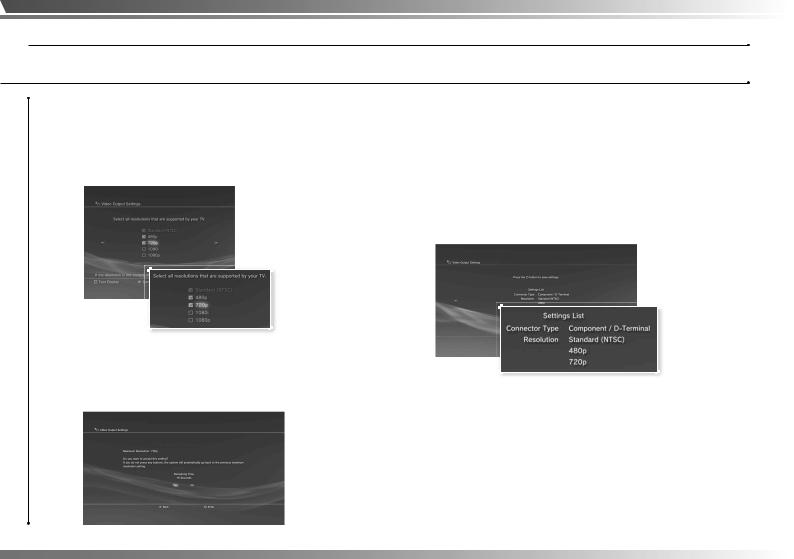
Getting started
Setting up the PS3™ system
5 Select the resolutions supported by the TV, and then press the  button.
button.
The resolution displayed on the TV varies depending on the input connector and the type of cable used (
 page 7). The highest resolution you selected will be used for video output. Depending on the connector selected in step 2, this screen may not be displayed.
page 7). The highest resolution you selected will be used for video output. Depending on the connector selected in step 2, this screen may not be displayed.
7
8
Select the type of TV, and then press the  button.
button.
If you selected an SD resolution or "480p" in step 5, a screen for selecting the TV screen size will be displayed. Adjust the setting to match the TV in use.
If you selected "720p" or a higher resolution in step 5, the TV type will automatically be set to 16:9 and the screen for selecting the TV screen size will not be displayed.
Confirm the settings, and then press the  button.
button.
The video output settings will be saved on the system.
6 Confirm the settings, select "Yes", and then press the
 button.
button.
Depending on the connector selected in step 2 and the resolutions selected in step 5, this screen may not be displayed.
14

Getting started
Setting up the PS3™ system
9 Adjust audio output settings.
Continue on to adjust audio output settings. Adjust settings to match the TV or audio device in use.
If you select "HDMI", you will have the option to choose "Automatic" or "Manual" on the next screen. In most cases, select "Automatic". If using a cable other than an HDMI cable to output audio from the TV, select "Audio Input Connector / SCART / AV MULTI". If using a digital optical cable to output audio, select "Digital Out (Optical)" and choose the output format on the next screen.
10 Confirm the settings, and then press the  button.
button.
The audio output settings will be saved on the system.
Hint
You can adjust audio output settings under  (Settings)
(Settings) 

 (Sound Settings)
(Sound Settings)  "Audio Output Settings".
"Audio Output Settings".
EN
CT
15

Basic operations
03 Turning the PS3™ system on and off
Using a wireless controller
Press the PS button.
Turning off the system
|
|
Press and hold down the PS button for |
PS button |
one second or longer. When the message |
|
|
|
"Turn Off the System" is displayed on the |
|
|
screen, select it, and then press the |
|
|
button. |
|
|
Hint |
|
|
Before using a wireless controller, you must fi rst |
|
|
pair it with the system ( page 17). |
Using the system button
1 Touch the power button. |
Power indicator status |
|
|
Solid green |
System turned on |
|
Flashing green |
System turning off |
|
Solid red |
System off (in standby mode) |
Power button |
Off |
Main power switch off |
|
|
|
Power indicator
2 Press the PS button of the wireless controller.
A controller number is assigned.
Turning off the system
Touch the power button for two seconds or longer.
Notice
Do not use the main power switch on the system rear to turn off a system that is not in standby mode (power indicator red), as doing so may cause data loss or damage to the system.
16
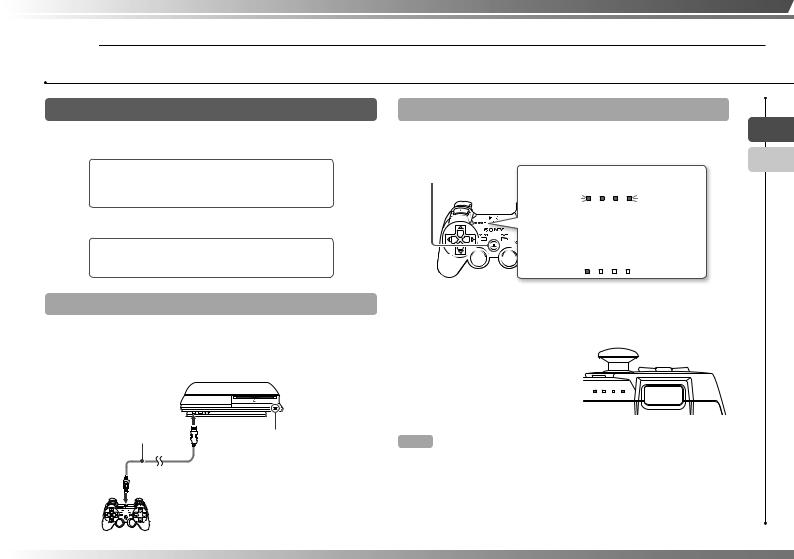
Basic operations
04 Using the wireless controller
Preparing for use |
Step 2: Assign a controller number |
To use a wireless controller, you must fi rst register or "pair" the controller with the PS3™ system and assign a number to the controller.
Each time you turn on the system, a number must be assigned to the |
EN |
|
|
controller. |
|
Step 1: Pair the system and the controller.
•When using for the fi rst time
•When using with a different PS3™ system
m
Step 2: Assign a controller number.
Every time the system is turned on
CT
Press the PS button. |
All of the port indicators fl ash. |
1 |
2 |
3 |
4 |
|
|
m |
|
When the controller has been assigned a |
|||
number, the port indicators for the |
|||
assigned number turn solid red. |
|||
1 |
2 |
3 |
4 |
Step 1: Pair the system and the controller
When using the controller for the fi rst time or when using with a different PS3™ system, you must fi rst pair the devices. If you turn on the system and connect the controller using a USB cable, the pairing will be completed automatically.
USB cable (supplied)  Check that the system is turned on
Check that the system is turned on  (power indicator is lit solid green).
(power indicator is lit solid green).
You can connect up to 7 controllers at one time. The controller number is shown by the number above the port indicators. For numbers 5-7, add the numbers of the lit indicators.
Example: Controller number 5 has |
|
been assigned. |
1 2 3 4 |
1
Hints
•Pairing and assigning controller numbers can only be done when the system is turned on (power indicator is lit solid green).
•When a paired controller is used with another PS3™ system, the pairing with the original system is cleared. Pair the controller with the system again if the controller has been used with another system.
•If the controller or the system is turned off, the port indicators on the
controller will turn off and the assigned number will be cleared. |
17 |
|

Basic operations
Using the wireless controller
Using the controller wirelessly
If you disconnect the USB cable, you can use the controller wirelessly. To use it wirelessly, the controller’s battery must be charged.
Hints
•The USB cable can be connected or disconnected while the controller and the system are turned on.
•If the controller does not function, press the PS button, and then reassign the controller number.
Charging the controller
With the system turned on (power indicator is lit solid green), connect the controller to the system using a USB cable. The port indicators of the controller fl ash slowly and charging begins.
When charging has completed, the port indicators stop fl ashing.
Hints
•The controller can be used while charging.
•Charge in an environment where the temperature range is between
10°C - 30°C (50°F - 86°F). Charging may not be as effective when performed in other environments.
•The battery has a limited lifespan. Battery duration will gradually decrease with repeated usage and age.
•Battery life also varies depending on the storage method, usage state, environment and other factors.
Battery charge level
If you press and hold down the PS button for more than one second, you can check the battery charge level on the screen.
 Charge level
Charge level
The battery has plenty of charge.
The battery has started losing its charge.
The battery charge level is low.
The battery has no charge. The port indicators of the controller fl ash rapidly. Charge the controller.
Hint
Depending on the environment or the conditions of use, the remaining charge level may not display correctly and the battery duration may vary.
18

|
|
Basic operations |
|
|
|
05 |
|
|
|
||
Playing content |
|
|
|
||
|
|
|
|
||
|
|
|
|
|
|
|
Blu-ray Disc (BD)/DVD/CD |
|
|
|
|
1 Insert the disc. |
2 An icon is displayed in the home menu, and playback of the |
EN |
|||
|
|
||||
|
|
|
disc begins. |
CT |
|
Insert the disc with the label side facing up.
Notices
•Discs that are not compatible with the system cannot be played. For details, refer to the "Safety and Support" document.
•To play commercially available BD video software, in some cases the encryption key* may need to be
renewed. The encryption key can be renewed when the system software is updated ( page 30).
page 30).
*AACS (Advanced Access Control System) key
If the disc does not automatically start, select the icon for the disc from the home menu, and then press the button.
button.
Ejecting a disc
Stop playback, and then touch the eject button.
Hint
For instructions on how to quit games, see "Playing games" ( page 21).
page 21).
Eject indicator
Eject button
19
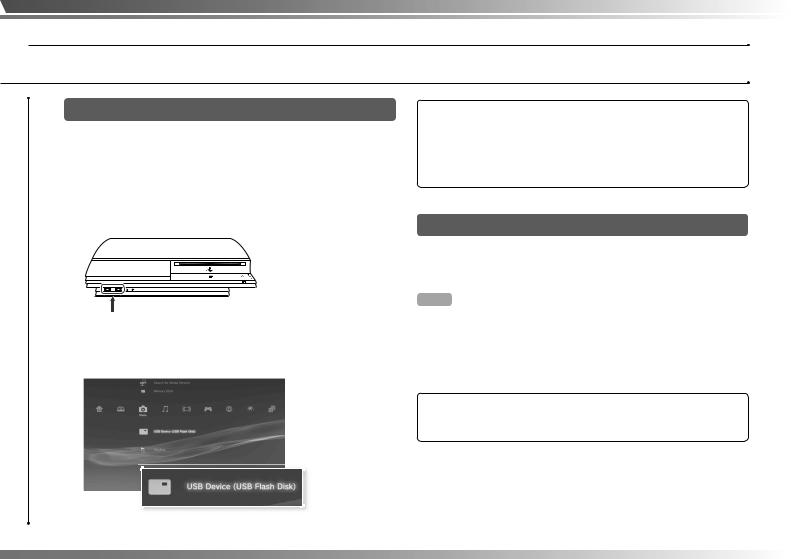
Basic operations
Playing content
USB devices |
Notices |
You can connect external devices, such as devices that are compatible with USB Mass Storage Class, using a USB cable. Devices can be connected while the system is turned on. Refer also to the instructions supplied with the device.
1 Connect the USB device.
An icon is displayed in the home menu.
External device such as a digital camera
2 Select the icon, and then press the button.
button.
A list of playable content is displayed.
•Do not remove USB devices or turn off the system while data is being saved, loaded or deleted. Doing so may cause data loss or corruption.
•When using a USB fl ash drive with a write-protect switch, do not operate the switch when the device is connected to the system. Doing so may cause data loss or corruption.
File formats that can be played or viewed
File formats that can be played or viewed on this system include ATRAC, MP3, AAC, JPEG and MPEG-4. For the latest information, refer to the online user’s guide (
 page 29).
page 29).
Hints
•Only fi les that are playable or viewable on the PS3™ system are displayed in the column for the compatible category (Example: Image data is displayed in the Photo category).
•Depending on the storage media, only a subset of the folders on the media may be displayed. If you select "Display All" from the options menu
(
 page 3), all folders saved on the media will be displayed.
page 3), all folders saved on the media will be displayed.
Notice
For information on backing up fi les saved on the hard disk, refer to the Safety and Support document.
20
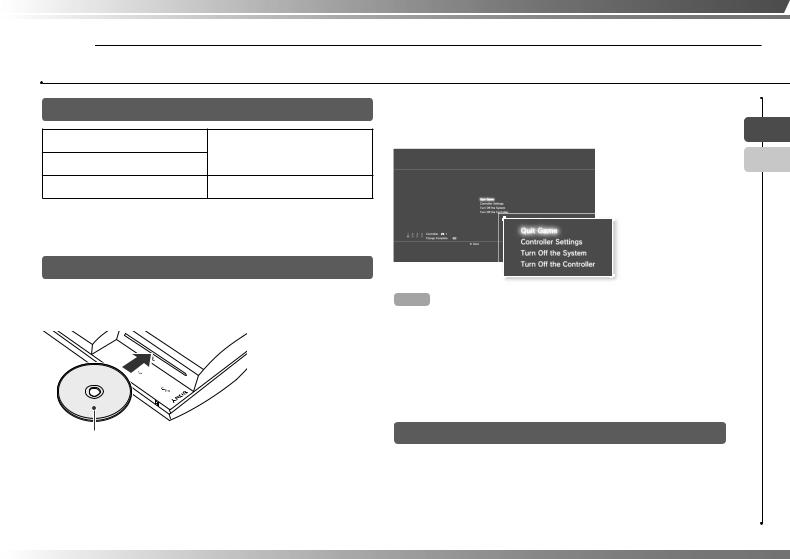
06 GamePlaying games
Games that can be played on this system
PLAYSTATION®3 format software
Can be played on this system *
PlayStation® format software
PlayStation®2 format software |
Cannot be played on this system |
*Operation of all PlayStation® format software titles is not guaranteed. Visit http://asia.playstation.com/status for the latest information on software that can be played on this system.
Playing games
Starting a game
When you insert a disc, the game starts automatically.
Insert the disc with the label side facing up.
Quitting a game
During gameplay, press the PS button of the Wireless Controller. Then
EN
select "Quit Game" from the screen that is displayed.
CT
Hint
Use the following methods when playing software titles that specify the controller mode and controller port to use.
−Press the PS button of the wireless controller, select "Controller Settings" "Switch Analog Mode", and then select the appropriate mode. With some software, the mode is switched automatically.
"Switch Analog Mode", and then select the appropriate mode. With some software, the mode is switched automatically.
−Press the PS button of the wireless controller, select "Controller Settings" "Reassign the Controller", and then assign the appropriate controller port.*
"Reassign the Controller", and then assign the appropriate controller port.*
*You cannot assign controller port 2-D using this system.
Saved data for PS3™ format software
Saved data for PS3™ format software is saved on the system’s hard disk. The data is displayed under (Game)
(Game) (Saved Data Utility).
(Saved Data Utility).
21
